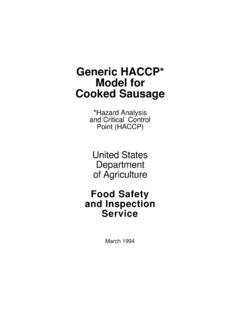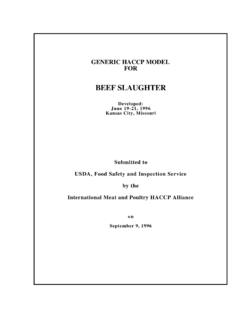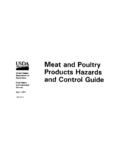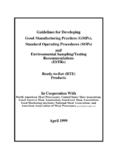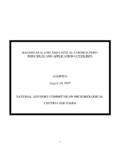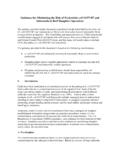Transcription of Fully Cooked, Not Shelf Stable - HACCP Alliance
1 generic HACCP MODELFORF ully cooked , Not Shelf StableDeveloped:June 26-28, 1996 Kansas City, MissouriSubmitted toUSDA, Food Safety and Inspection Serviceby theInternational Meat and Poultry HACCP AllianceonSeptember 9, 1996 Fully cooked , Not Shelf StableTABLE OF CONTENTS SECTION PAGE Introduction ..2 Seven Principles of About this generic model ..4 Using this generic model to Develop and Implement a HACCP Program ..6 Process Category Categories and Charts ..12 Hazard Analysis Worksheet ..15 HACCP Worksheet ..31 Examples of Record-Keeping Forms ..36 Appendix 1 (21 CFR Part 110)..40 Appendix 2 (Process Categories)..50 Appendix 3 (Overview of Hazards) ..52 Appendix 4 (NACMCF Decision Tree) ..54 Appendix 5 (References) ..56 Fully cooked , Not Shelf StableGENERIC HACCP MODELFORF ully cooked , Not Shelf - Stable INTRODUCTIONH azard Analysis Critical Control Point ( HACCP ) is a systematic, scientific approach to process control.
2 Itis designed to prevent the occurrence of problems by ensuring that controls are applied at any point in afood production system where hazardous or critical situations could occur. Hazards can includebiological, chemical or physical contamination of food United States Department of Agriculture (USDA) published a final rule in July 1996 mandating thatHACCP be implemented as the system of process control in all USDA inspected meat and poultry part of its effort to assist establishments in the preparation of plant-specific HACCP plans, FSIS determined that a generic model for each process defined in the regulation will be made available for use bythe May 1996, the Department of Agriculture (USDA) Food Safety and Inspection Service (FSIS)awarded Contract Number 53-3A94-6-04 to the International Meat and Poultry HACCP Alliance for thedevelopment of ten generic HACCP models.
3 The ten models developed were:1. Not Heat Treated, Shelf - Stable (dried products, those controlled by water activity, pH, freezedried, dehydrated, etc.)2. Heat Treated, Shelf - Stable (rendered products, lard, etc.)3. Heat Treated Not Fully cooked , Not Shelf - Stable (ready to cook poultry, cold smoked andproducts smoked for trichinae, partially cooked battered, breaded, char-marked, batter set, and lowtemperature rendered products, etc.)4. Products with Secondary Inhibitors, Not Shelf - Stable (products that are fermented, dried, salted,brine treated, etc., but are not Shelf - Stable )5. Irradiation (includes all forms of approved irradiation procedures for poultry and pork)6. Fully cooked , Not Shelf Stable (products which have received a lethal kill step through a heatingprocess, but must be kept refrigerated.)
4 This includes products such as Fully cooked hams, cookedbeef, roast beef, etc.).7. Beef Slaughter8. Pork Slaughter9. Poultry Slaughter10. Raw Products - not ground (all raw products which are not ground in their final form. Thisincludes beef trimmings, tenderized cuts, steaks, roasts, chops, poultry parts, etc.)USDA developed the following three models:1. Raw, Ground2. Thermally Processed/Commercially Sterile3. Mechanically Separated SpeciesThis document contains the generic HACCP model for the process category titled: Fully cooked , NotShelf order to develop this model , a literature review and an epidemiological assessment of the productsselected were performed to present an overview of the microbiological characteristics and profile of theproduct. This information then was reviewed by a team of industry, academic, public health officials, andFully cooked , Not Shelf Stableconsumer representatives.
5 The team met in a workshop in Chicago, Illinois on May 29-31, to the workshop, this generic HACCP model was review by small business establishments forclarity and usability, and it was submitted to an expert peer review panel for technical HACCP plans serve as useful guidelines; however, it is impossible for a generic model for awhole class of meat products to be developed without it being too general. Therefore, it is incumbent oneach plant s HACCP Team to tailor this model to fit products in each plant, based on the knowledge aboutthe product. Several points should be considered when using this model to develop specific HACCP plans. All plants should have Sanitation Standard Operating Procedures (SSOPs). It is recommended thatGood Manufacturing Practices (GMPs) and Standard Operating Procedures (SOPs) be in place as thefoundation of the HACCP generic model can be used as a starting point for the development of your plant-specific planreflecting your plant environment and the specific processes conducted.
6 The generic model is not intendedto be used as is for your plant-specific HACCP generic models designed for use in developing a plant-specific HACCP plan are defined according toprocess category. In order to select the model or models that will be most useful for the activitiesperformed in your plant, the following steps should be a model for a slaughter operation is required, select the model for the appropriate species. If a model fora processed product or products is required, make a list of all products produced in the plant. Examine thelist and group all like products according to common processing steps and equipment used. Comparethese to the list of Process Models in Appendix 2. After reviewing and grouping the products produced,you will know the number of models that are needed to assist in developing your plant-specific an establishment is a combination plant, conducting both slaughter and processing activities, the twomodels can be merged into a plant-specific plan.
7 In this case, over-lapping critical control points (CCPs)can be combined as long as all significant hazards are Principles of HACCP :The following seven principles of HACCP were adopted by the National Advisory Committee onMicrobiological Criteria of Foods (NACMCF, 1992):1. Conduct a hazard analysis. Prepare a list of steps in the process where significant hazardsoccur and describe the preventive types of hazards: Biological (B) primarily concerned with pathogenic bacteria, such as Salmonella,Staphylococcus aureus, Campylobacter jejuni, Clostridium perfringens, Clostridiumbotulinum, Listeria monocytogenes, and Escherichia coli O157:H7; also shouldconsider Trichinella sprialis, and other parasites, as well as potential pathologicalconcerns. Chemical (C) toxic substances or compounds that may be unsafe for consumption; ,cleaners, sanitizers, pesticides, insecticides, rodenticides, paint, lubricants, etc.
8 Physical (P) foreign objects which may injure the consumer; , rocks, stones, wood,metal, glass, nuts, bolts, screws, plastic, knife blades, Identify the critical control points (CCPs) in the process. A critical control point is defined as apoint, step or procedure at which control can be applied and a food safety hazard can beprevented, eliminated or reduced to an acceptable Establish critical limits for preventive measures associated with each identified CCP. A criticallimit is defined as a criterion that must be met for each preventive measure associated with aFully cooked , Not Shelf StableCCP. Each CCP will have one or more preventive measures that must be properly controlledto assure prevention, elimination or reduction of hazards to acceptable levels. Each preventivemeasure has associated with it critical limits that serve as boundaries of safety for each Establish CCP monitoring requirements.
9 Establish procedures for using the results ofmonitoring to adjust the process and maintain Establish corrective action(s) to be taken when monitoring indicates that there is a deviationfrom an established critical Establish effective record-keeping procedures that document the HACCP Establish procedures for verification that the HACCP system is working about this generic model :1. Products Included In This model . This model deals only with the PROCESS CATEGORY, Fully cooked , Not Shelf Stable . This model deals only with the traditional products in the class of eithersnack sticks or jerky. Many products are manufactured with different characteristics which may beconsidered heat treated, Shelf - Stable but are much higher in moisture content than these products. Some ofthese products, such as summer sausage sticks , kippered beef and pickled sausages, are generallyconsidered Shelf - Stable but are not included in this Items Addressed.
10 This model does provide a discussion of some hazards associated with sanitationand preventive measures. This model does not address certain aspects of product safety, such as allSanitation Standard Operating Procedures (SOPs) and Good Manufacturing Practices (GMPs). SanitationSOPs are required by FSIS as part of the prerequisite HACCP Critical Control Points. For each CCP, the following were identified and presented: critical limits,monitoring procedures, corrective action procedures, HACCP records to maintain, and methods forHACCP system verification. The Critical Control Points in this model were established by the teammembers of the workshop. Some products or processes may require fewer or more CCPs depending onthe individual Product Flow. In the product flow, only the general term Processing was used.
